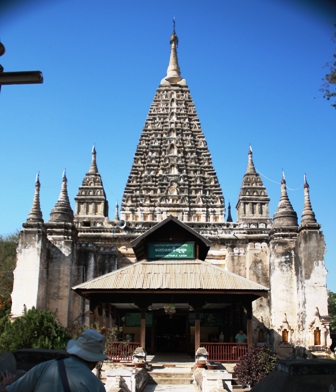
Click the photo above to see an album of photos. To return to our website close the window.
Read previous Ancient Cities or next Delta Temples and Caves
16 January 2010 Bagan
Never again will I complain about the poor quality of roads in Ontario or even Quebec. They are in pristine condition compared to the main through fares in Myanmar. Our seven hour bus ride from Mandalay to Bagan demonstrated that. Our first choice was to motor down the Ayeyarwady River for a relaxing eight to nine hours on the Express boat but there were no seats available until the 18th of January, far too late for our schedule. There is a slow boat but it takes 12 to 15 hours. Our rejection of that option was a good decision. I later met tourists who took the slow boat and arrived 27 hours after they left Mandalay. It did not sound like fun.
Even though it costs many times more than the bus, I would recommend flying. Some of the roads we traveled on where literally under construction. I think they use the bus and truck traffic to pack down the stone and gravel being spread on the road. I am not sure if there was any intention to pave the road. The countryside was flat and boring after a while and the promised AC was barely there. At least we had assigned seats. We stopped at village after village picking up yet more passengers. The lucky ones had stools in the aisle while the late comers crowded at the front of the bus.
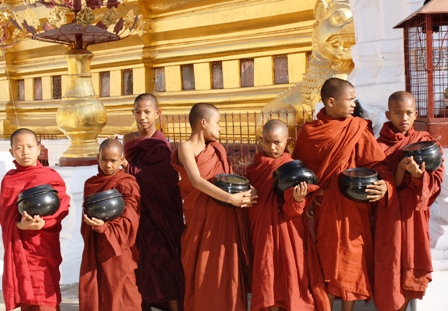
In the 11th C the Mon King, who ruled a huge area from the Ayeyarwady River Delta south of Yangon east as far as Thailand and even into Cambodia, sent a monk to convert the Bagan King to Theravada Buddhism from Mayayana Buddhism, the variation prevalent in India. The Bagan King embraced the new Buddhism so fervently he went into a temple building frenzy that lasted 230 years until the area was over run by the Mongols under Kublai Khan in 1287. By that time there were 4,400 temples strewn over the plains of Bagan.
Blame is laid on the Mongol invasion for the destruction of Bagan but other historians say that the current king panicked at the threat of a Mongol invasion and destroyed many of the temples to build fortifications. Then he fled the area before any of the invaders arrived. Nevertheless, the area was deserted for the next 4 centuries. It was said to possess bad spirits so only bandits dared live there. The people only moved back to Bagan after the British established a base in the mid-18th C. In the meantime the temples were subject to natural erosion, looting, damage from bat dung and even earthquakes, including a devastating one in 1975. UNESCO has been active in the area since the earthquake, cleaning murals and helping repair damage to structures.
Bagan has three main residential and hotel areas. We stayed in Nyaung U with the most economical hotels, guest houses and restaurants. About 3 km away is Old Bagan, with a thriving local market and a few good restaurants. We ended up in Old Bagan for lunch every day. Since it is closest to the most popular temples, it also has several high end hotels. In 1990 the government moved the villagers who had settled in Old Bagan to New Bagan, 3 km farther south. People have returned to Old Bagan to live in a shanty town behind the market while New Bagan remains a quiet area with a few budget guest houses and restaurants and a few very good high end establishments. We had a relaxing morning break in New Bagan admiring the river view from the terrace of a small restaurant.
A word about food: the variety in all of Myanmar is endless, the price is very reasonable and the quality, even from the simplest establishments is very good. We have enjoyed Chinese, Indian, Thai, Bamar (the largest ethnic group in Myanmar), Shan (one of the hill tribes). Italian, French and Korean are also available, just take your pick.
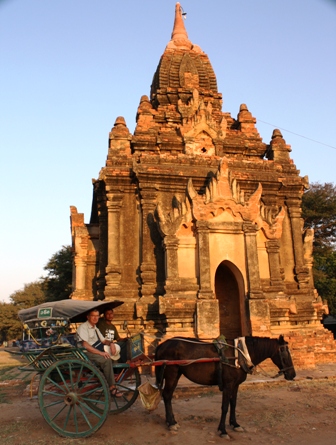
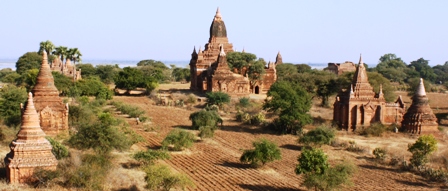
Sometimes I am tempted to describe Bagan as the biggest souvenir market in the most beautiful setting in Myanmar. Almost every temple had an array of souvenirs for sale at its front entrance. There were T-shirts, brass ornaments, traditional painting on cloth, lacquer ware, postcards and even gems of dubious quality. For such an important stop on the tourist trail Bagan was not crowded. Except for the occasional tour group, there were very few other tourists at each of our stops. That meant there was a dearth of customers for the vendors and their products were often very good. That also meant some vendors were a little too assertive in their approaches to a possible buyer. We learned to not get annoyed and to pleasantly talk with the locals and politely tell them we were not buying.
As we learned in Nepal, we do not give money, pens or candy to the children. It only encourages them to expect a handout from every tourist and does not help their impoverished condition. You are encouraged instead to give donations of money or supplies directly to a school or aid organization that will ensure the children in greatest need receive the benefits. Two small children wouldn’t take bye-bye for an answer at one temple and followed me inside. When they indicated they were willing to pose for me I couldn’t resist and we ended up having fun getting the right expressions. I gave them two small shampoo packets from our hotel as a thank you. This was enough to send them away very happy with the transaction.
We made one non-temple stop at a lacquer workshop in the village of Myinkaba, between Old and New Bagan. It is the center of lacquer ware production, the most popular purchase in Myanmar. I had no idea it was such a complicated process and so time consuming and it is all done by hand. Everywhere you go in Myanmar you will pass shops displaying bowls, cups, trays, boxes, vases and even furniture for sale. Lacquer is produced from the sap of a tree and must be filtered many times before it can be used. The frame of the item is woven from bamboo strips and the better pieces are wrapped in horsehair. The item is then coated in lacquer, dried for two weeks, polished and the lacquer process repeated up to 18 times. Only then is it ready for the decoration process. Designs are etched onto the lacquer surface by hand and colours applied one at a time using a batik method. There are no shortcuts taken to produce a quality item. We were able to observe workers at each one of the steps necessary to produce a finished product. We couldn’t resist buying a few small items to take home as souvenirs.
The next two days we rented crummy Chinese bicycles and set out to visit some of the temples we didn’t get to on our horse and cart tour. A mountain bike is what is really needed to navigate the paths to the temples, but it is rare to find one in Myanmar. There are just two paved roads and the temples are all off the road on dirt roads. This is the dry season and some of the roads were just soft sand. We had to push the bikes through those sections. We even pushed them across a few plowed but unseeded farmer’s fields to get from one temple to the next. It did get us where we wanted to go and gave us a little more exercise than sitting in a horse cart but it is not for the faint of heart.
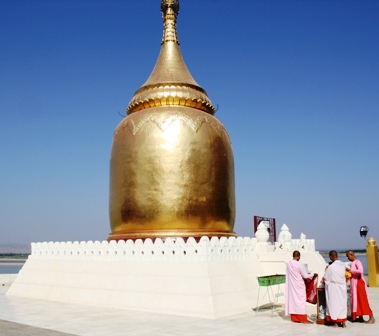
Wasn’t that thoughtful of the heavens to arrange a solar eclipse for our Bagan visit? We couldn’t believe our luck and the skies were clear blue for our viewing pleasure. The eclipse on the 15th of January could be seen in parts of Africa and Asia, including just where we were. It was an annular eclipse, when the diameter of the moon is appears to be smaller than the sun. That meant that there was a bright halo around the moon at the peak of the eclipse.
If possible, every tourist made sure they stayed in town long enough for the eclipse, scheduled to be at its height around 3 PM. We were just finishing our lunch in a small restaurant in Old Bagan when two of the employees dragged a shallow bowl of water to the area just outside the restaurant. There were another two bowls of water set up outside an adjacent restaurant. These were intended to let us view the eclipse as a reflection in the water. Even the reflection was too bright for me. One local man had a piece of film that worked well.
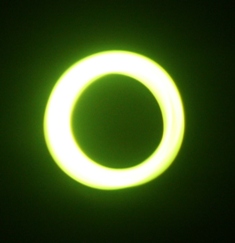
One English woman we were talking to asked if I could send her my eclipse photos by email as her camera didn’t work well enough for good photos. In conversation with her and her husband we discovered he might be a long lost cousin! John Burnham said he does not know many other Burnhams in England so it was a big surprise to meet us. He and his wife had rented out their house in England and were on a three year odyssey, mostly in Asia. They had already spent more than two years and were a good source on where to go in Indonesia, our next destination. What an end to our visit to Bagan.